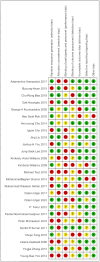Exercise prescription for improving chronic low back pain in adults: a network meta-analysis
- PMID: 40520315
- PMCID: PMC12162995
- DOI: 10.3389/fpubh.2025.1512450
Exercise prescription for improving chronic low back pain in adults: a network meta-analysis
Abstract
Objective: This study aims to investigate the impact of various combinations of exercise prescription variables-namely type, duration, frequency, and period-on improving chronic low back pain (CLBP) in adults. The goal is to provide evidence to inform the development of exercise prescriptions for CLBP interventions.
Methods: Data sources were obtained from EBSCO, PubMed, Web of Science, Embase, and Cochrane, with the search conducted up to June 30, 2024. Two independent reviewers screened the literature, extracted data, and assessed the risk of bias in the included studies. A network meta-analysis (NMA) was performed using Stata 17.0 software, and the surface under the cumulative ranking (SUCRA) was utilized to rank the effectiveness of the exercise prescription variables.
Results: Significant effects were observed for durations of 15-30 min [SMD = -1.62, 95% CI (-2.32, -0.92)] and ≥60 min [SMD = -0.81, 95% CI (-1.58, -0.03)] when compared to the control group. Intervention periods of 4 weeks [SMD = -1.82, 95% CI (-3.37, -0.28)], 12 weeks [SMD = -1.18, 95% CI (-1.85, -0.51)], and ≥16 weeks [SMD = -2.75, 95% CI (-4.26, -1.24)] also resulted in significantly better outcomes compared to the control group. The intervention effect for durations of ≥16 weeks was significantly greater than that for 12 weeks [SMD = -2.17, 95% CI (-3.58, -0.47)] and 6 weeks [SMD = -2.18, 95% CI (-3.85, -0.45)]. A frequency of three sessions per week [SMD = -1.44, 95% CI (-2.09, -0.78)] demonstrated significantly superior outcomes compared to the control group. An intervention duration of 15 to 30 min (SUCRA = 94.6), three sessions per week (SUCRA = 87), an intervention period of ≥16 weeks (SUCRA = 95.4), and Tai Chi exercise (SUCRA = 77.4) may be the most effective approaches for improving chronic low back pain in adults.
Conclusion: Tai Chi exercise, lasting 15 to 30 min per session, performed three times a week over an intervention period of at least 16 weeks, may represent the most effective intervention for alleviating chronic low back pain in adults. However, due to the limited number of studies included, further research is necessary to provide stronger evidence.
Keywords: Tai Chi; chronic low back pain; exercise prescription; intervention effectiveness; network meta-analysis.
Copyright © 2025 Zhao, Zhang, Li and Li.
Conflict of interest statement
The authors declare that the research was conducted in the absence of any commercial or financial relationships that could be construed as a potential conflict of interest.
Figures










Similar articles
-
Optimal exercise dose and type for improving sleep quality: a systematic review and network meta-analysis of RCTs.Front Psychol. 2024 Oct 3;15:1466277. doi: 10.3389/fpsyg.2024.1466277. eCollection 2024. Front Psychol. 2024. PMID: 39421847 Free PMC article.
-
Interventions used in control group against cupping therapy for chronic nonspecific low back pain: A systematic review and network meta-analysis.Complement Ther Med. 2025 Jun;90:103167. doi: 10.1016/j.ctim.2025.103167. Epub 2025 Mar 22. Complement Ther Med. 2025. PMID: 40127849
-
Yoga compared to non-exercise or physical therapy exercise on pain, disability, and quality of life for patients with chronic low back pain: A systematic review and meta-analysis of randomized controlled trials.PLoS One. 2020 Sep 1;15(9):e0238544. doi: 10.1371/journal.pone.0238544. eCollection 2020. PLoS One. 2020. PMID: 32870936 Free PMC article.
-
Parkinson's disease motor intervention patterns: a network meta-analysis based on patient motor function.Front Neurol. 2024 Sep 5;15:1432256. doi: 10.3389/fneur.2024.1432256. eCollection 2024. Front Neurol. 2024. PMID: 39314864 Free PMC article.
-
Efficacy of aerobic exercises for knee osteoarthritis: a network meta analysis of randomized clinical trials.J Orthop Surg Res. 2025 Jun 2;20(1):557. doi: 10.1186/s13018-025-05973-z. J Orthop Surg Res. 2025. PMID: 40452037 Free PMC article.
References
Publication types
MeSH terms
LinkOut - more resources
Full Text Sources
Medical

